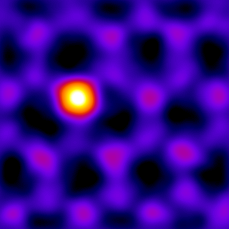Moving atoms with an electron beam
Different materials each have specific and unique properties depending on their chemical structure – the arrangement of their atoms. Two-dimensional (2D) materials consisting of only one layer of atoms offer completely new possibilities. Graphene is such a 2D material where carbon atoms (gray balls in the model below) are arranged in a honeycomb lattice.
Electron microscopes enable much greater resolution than optical microscopes, which use visible light and can thus only image objects down to a thousandth of a millimeter. Electron microscopes use electron beams instead and can image much smaller objects, down to individual atoms. The Nion UltraSTEM scanning transmission electron microscope at the University of Vienna allows a 50,000,000x magnification, with each carbon atom of the graphene lattice resolved as a bright spot (simulated image below).
Occasionally, one can find silicon impurities within the graphene lattice. Since image contrast depends on how strongly electrons are scattered by each atom – which in turn is determined by the charge of the nucleus, with silicon having more protons than carbon – we can directly see the impurities (larger yellow balls in the model below) in electron microscopy images (image below).

In addition to imaging, we can use the focused electron beam of the microscope to move atoms (animation below). Each electron has a small chance of being scattered back by the nucleus of a targeted atom, giving it a small push in the opposite direction (video above). In practice, we direct the electron beam by moving a mouse cursor on a computer screen controlling the microscope to where we want to drag the impurity (hence the name “tractor beam“). Visit the online simulation game experience yourself how we can manipulate atoms!
